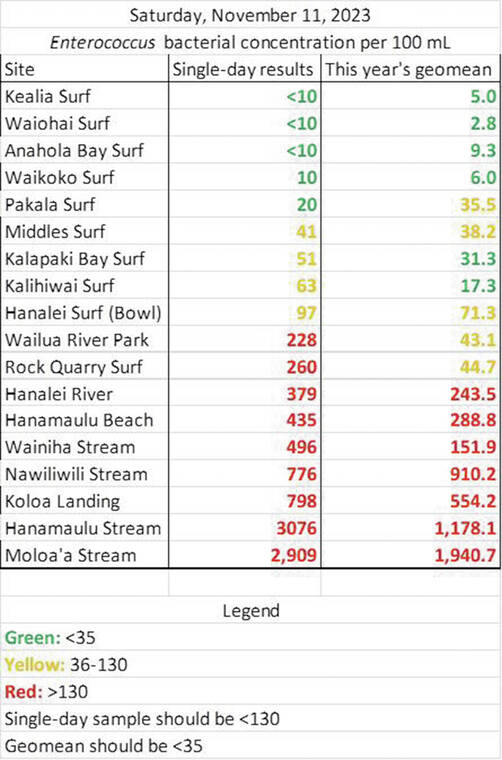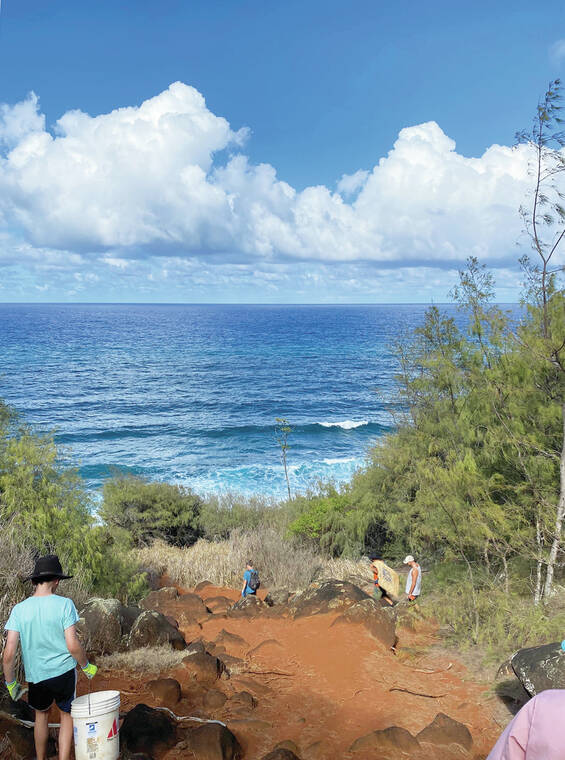Rainy season affecting water quality on Kaua‘i


LIHU‘E — The Surfrider Foundation has released its Nov. 11 water quality results for the island, with its senior scientist attributing higher than average bacteria levels at many of the tested sites to the beginning of the rainy season.
Meanwhile, as senior scientist Carl Berg has continued to report several of the island’s streams, beaches and surf spots are heavily polluted with human fecal matter, the state Department of Health says the presence of the fecal indicating bacteria is not “exclusively of fecal origin,” and the bacteria “can be part of the natural microflora environment.”
Testing for enterococci is required under Hawai‘i law to check for water quality and human wastewater.
Surfrider’s testing is completed by volunteers with the environmental nonprofit, who sample 18 different locations around the island on the second Saturday of every month to test for enterococci, a bacteria indicating the presence of fecal matter in the water.
Berg reported that rains on the island, beginning at the start of the month, have caused surface water runoff and groundwater discharge into the streams.
“This is why we are now seeing single-day counts for (Nov. 11) higher than their average for the year,” he said.
The Surfrider report marked sites in red, yellow or green, depending on their levels of enterococci. Sites marked in red, or most heavily polluted, were Moloa‘a Stream, Hanamaulu Stream, Koloa Landing, Nawiliwili Stream, Wainiha Stream, Hanamaula Beach, Hanalei River, Rock Quarry Surf and Wailua River Park.
Those sites, listed in order from most to least polluted, had bacteria levels from 2,909 per 100 milliliter (ml) to 228 per 100 ml. Surfrider considered areas with concentrations higher than 130 per ml as having a high level of fecal-identifying bacteria.
Sites in the yellow, with bacterial concentrations between 36-130 ml, were Hanalei Surf, Kalihiwai Surf, Kalapaki Bay Surf and Middles Surf
Lastly, the sites in the green, or the cleanest waters, were Pakala Surf, Waikoko Surf, Anahola Bay Surf, Waiohai Surf and Kealia Surf.
“Surfrider wants to remind everyone that the streams on Kaua‘i are chronically polluted with fecal indicating bacteria and streams pollute ocean waters where they discharge into the ocean. If the water is brown, be especially careful and be sure to rinse off thoroughly,” said Berg in an email to The Garden Island.
He advised the public to follow brown water advisories from the Department of Health (DOH) to determine what water is safe to enter.
The DOH recently issued several brown water advisories, including one for the whole island on Nov. 17.
“Heavy rain has resulted in stormwater runoff entering into coastal waters. The public is advised to stay out of flood waters and stormwater runoff due to possible overflowing cesspools, sewers, manholes, pesticides, animal fecal matter, dead animals, pathogens, chemicals and associated flood debris,” the advisory said. “Not all coastal areas may be impacted by runoff, however, if the water is brown stay out.”
The department, which does its own testing separate from Surfrider, also issued a high bacteria count notification for sites including Po‘ipu Beach Pavilion (enterococci levels of 782 per 100 ml), Wai‘oli Beach Park (levels of 254 per 100 ml), Anini Beach (levels of 178 per 100 ml) and Kalapaki Beach (levels of 164 per 100 ml).
In each announcement, the department said they were uncertain about the “representativeness” of the samples, saying the beaches have “historically met acceptable levels of the bacteria and there is no known source of fecal contamination.”
The DOH says it is retesting the sites and will notify the public of the results. The department also issued several other water quality advisories last month.
As the department says there is “no known source” of the contamination, Berg told The Garden Island that the Wai‘oli has cesspools all along the stream that empty at the beach.
He wants caution signs placed at that stream, and other areas, including Koloa Landing and Nawiliwili Stream, that he said are known to be “historically polluted.”
Berg criticized the DOH in an email on Nov. 17, saying the department has neglected to test stream mouths, which is where human wastewater enters the ocean. He also said the DOH only tests at historically clean beaches, when the water is not brown, and should be testing more often.
Shawn Hamamoto, a spokesperson for the DOH, told The Garden Island that the department’s Clean Water Branch tests a total of 12 coastal waters once a month: Anahola Beach, Ha‘ena Beach County Park, Hanalei Beach County Park (Hanalei Bay Pavilion), Kalapaki Beach, Kealia, Ke‘e Beach, Kekaha Beach County Park, Lydgate State Park, Po‘ipu Beach County Park, Salt Pond Beach County Park, Wai‘ohai Beach and Wai‘oli Beach Park.
He named the waters of 25 other beaches that are tested every two to three months “due to less frequent public use.” Those beaches are: Anini Beach, Beach House Beach, Brennecke Beach, Gillin’s Beach, Hanama‘ulu Beach County Park, Kalihiwai Bay, Kapa‘a Beach County Park, Kawailoa Beach, Koloa Landing, Kukui‘ula Bay, Lumaha‘i Beach, Moloa‘a Bay, Niumalu Beach Park, Nukoli‘i Beach Park, Pacific Missile Range Facility, Pakala (Makaweli), Polihale State Park, Prince Kuhio Park, Sheraton Beach, Shipwreck Beach, Tunnels Beach, Waikoko Bay, Wailua Beach, Waimea Recreation Pier State Park and Waipouli Beach.
Hamamoto noted the DOH is required to notify the public when the Beach Action Value (BAV) for the fecal bacteria enterococci, exceeds 130 per 100 ml — the same threshold level as the Surfrider Foundation.
“Please note that the presence of enterococci has been shown to be naturally occurring in the environment and is not itself a pollutant,” he said.
•••
Emma Grunwald, reporter, can be reached 808-652-0638 or egrunwald@thegardenisland.com.
